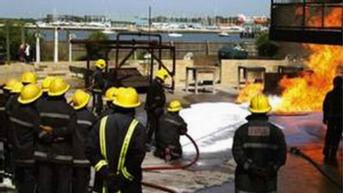ICCARUS

This is a screen shot from ICCARUS - a multi-media learning simulator, devised by staff from Portsmouth University, who worked closely with fire officers and staff the National Fire College. The simulator simply coached working fire officers in the most effective ways of controlling major fire incidents. It has been successful used to train a new generation of effective fire officers. It was initially designed as a prototype to convince the British Home Office that it was possible to produce a fairly low cost simulator, using the then newly available laser video discs and an Apple computer to replicate the situations fire offer controllers find themselves in the Control Module at a major incident. The large screen
on the Apple computer, with its iconic control images which looked like small ‘stick-its’, looked very similar to the incident board in used in the Command Module; this gave the officers a very real visualisation familiar to them, immersing them into the equivalent of a real fire control event. The simulation package allowed the fire officers to ‘fight the fire’ in the best way they knew how - processes which then could only be learned from books or in an actual fire. So now they felt immersed in an actual incident made mistakes and some successes, learning from them in an experiential way. The computer stored their actions in simple charts which helped the fire officer learn for themselves where they had done well and where not, or more often charts which enabled their trainers to coach them into better actions. The experience was so real to those engaged in the simulator that they reported feeling they were in the ‘hot seat’ and many also reported they felt the ‘call of the fire’ – a situation which so often leads them to incorrect decision-making and action.
One of the most important parts of this Academic Enterprise was the way it was developed with the creative university design team. From the start of the development the team worked extremely closely with a large cohort of practicing fire officer to co-create and co-produce the simulation. So whatever the creative team did for four days in any week, they would test the prototype on the fifth day and then modify it continuously to perform better and better. Successive formative evaluation of the simulator resulted in an improving and more appropriately realistic learning tool, even though the underpinning modelling of the fire was fairly rudimentary; in short it was good enough to represent the fire and its development in a relevant way.
The project was deemed to be such a success, that it was formally and independently evaluated in a large scale socio-psychological study initiated by the British Government Ministry of Trade and Industry. John Whatmore, who undertook this evaluation, assessed it as being the most creative project lead by a creative University leader. Whatmore used this as one of five examples of the best practice creative leadership of creative teams; for more details of this please read: ‘Releasing Creativity’ by John Whatmore (1999) published by Kogan Page. Key in this University led enterprise was its co-creating elements. Firstly the team to undertake the project were carefully selected to have appropriate functional and team skills. It was then facilitated so it could work in a trans-disciplinary ways; this seemed to release their talents in a mutually supportive way, where the sum of the parts was worth more than the parts themselves. Team-working skills continued to be honed as the projects life cycle unfolded, and the team itself had to be motivated to cope with increasingly more difficult problems. In all this the importance of good team working and even better leadership was shown to be important in the progress of this development. There was huge team spirit throughout the entire project development which gave all great satisfaction, enjoyment and learning, as well as a sense of real and lasting achievement.
The award winning solution became extensively used across the entire UK to train a new generation of effective fire officers. In terms of impact, the simulator was used effectively to coach those who then led a number of major fires, especially at the Arndale major terrorist Shopping incident in Manchester. It also led some of the creative team to reform to develop further command and control simulators for the UK police force concerning football evacuation control, siege control and the Notting Hill Festival.
 Printer-friendly version
Printer-friendly version- Login to post comments
- 144 reads






